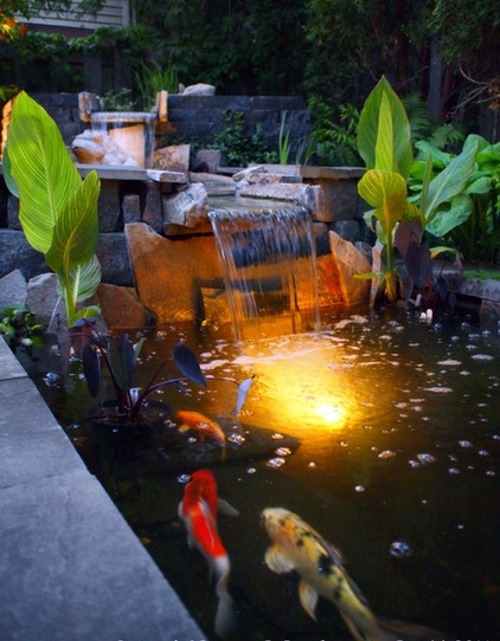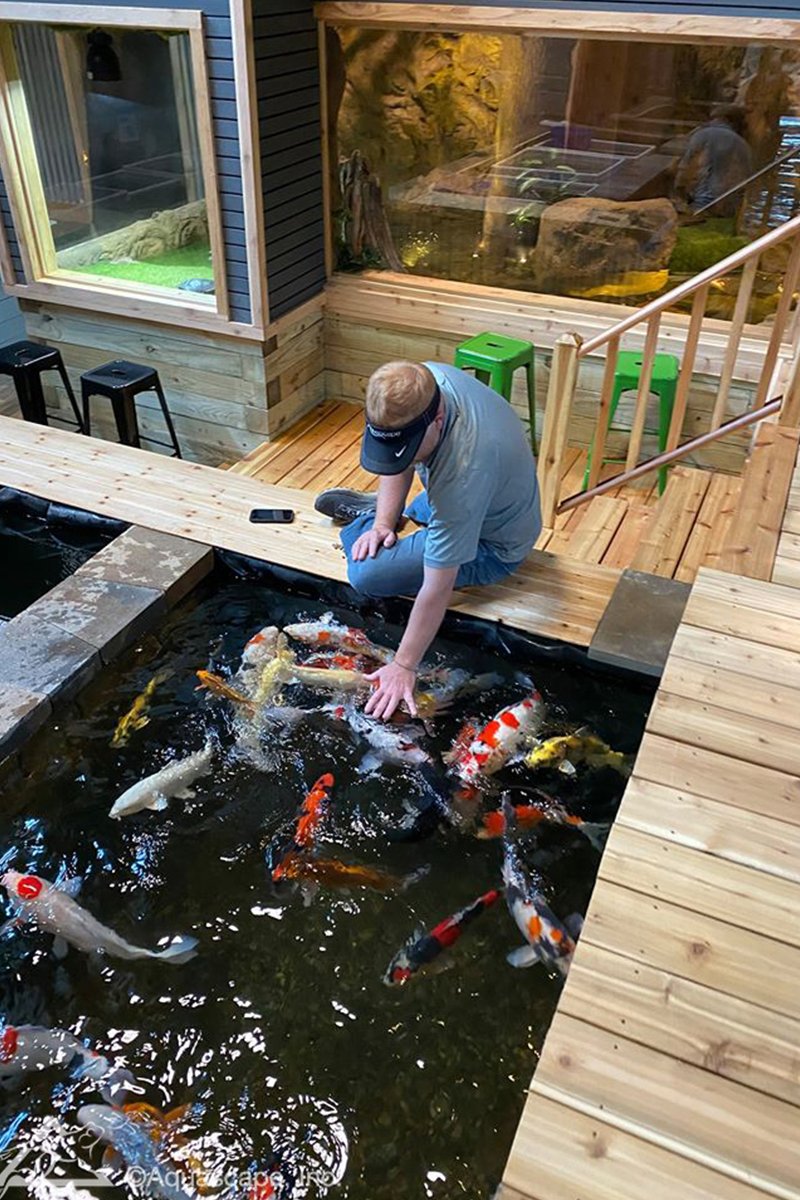Koi pond in winter information
Home » » Koi pond in winter informationYour Koi pond in winter images are ready. Koi pond in winter are a topic that is being searched for and liked by netizens now. You can Download the Koi pond in winter files here. Find and Download all free images.
If you’re searching for koi pond in winter pictures information connected with to the koi pond in winter topic, you have pay a visit to the ideal blog. Our site frequently provides you with suggestions for seeking the highest quality video and picture content, please kindly surf and find more informative video articles and images that match your interests.
Koi Pond In Winter. A fine weave aquarium net and pond vacuum are both very helpful for this process. Nishiki koi or japanese ornamental. Since winter is just around the corner, you’ll need a survival guide to winterize your koi pond. Leaving your koi in the pond through the winter is the least taxing way to winterize.
 koi Pond From paradisepondsandwaterfalls.com
koi Pond From paradisepondsandwaterfalls.com
If you find your pond is hard to keep clean in the late fall, you can install pond nets to keep dead branches and falling leaves out. If you�re fortunate enough to live in a warm climate, your pond can stay active all winter. Leaving the net over the pond for the winter months is not a good idea because it can not handle a snow load. (this is necessary for all but the smallest of your koi. Koi fish can survive cold water as long as the temperature is more than 35 degrees fahrenheit. In the wintertime, when the water in your pond is ice cold, the koi fish�s metabolism slows down to a crawl.
Moving the koi to an indoor pond.
You can leave your koi in the pond during the winter, as long as it is at least four feet deep. As the water in your pond gets colder, things will start to happen. Because they are with a reduced metabolism resting in the pond and if suddenly you approach and make some sudden movement you frighten them and cause them to flee intuitively. Generally the koi in winter are usually “parked” at the bottom of the pond. Aquatic life needs a bit of debris for burrowing during the winter, but too much will deoxygenate the water in your koi pond and produce toxic gases. Koi will stop eating once the temperature gets below 50°f.
 Source: nextdaykoi.com
Source: nextdaykoi.com
The winter season allows the koi to effectively get rid of some of this excess fat and in the case of females, allow them to slim off so they have the chance to reach next season when hopefully they can spawn to release their eggs. Because they are with a reduced metabolism resting in the pond and if suddenly you approach and make some sudden movement you frighten them and cause them to flee intuitively. Koi will stop eating once the temperature gets below 50°f. There are several ways you can keep the pond warm for your koi fish. Now you can begin to cut back all of your aquatic plants to the proper height for their winter slumber.
 Source: avso.org
Source: avso.org
Now you can begin to cut back all of your aquatic plants to the proper height for their winter slumber. There is limited time left this season to introduce koi to your pond. Just make sure to drain and clean any water pumps, filters, and water lines not in use. If you find your pond is hard to keep clean in the late fall, you can install pond nets to keep dead branches and falling leaves out. Try a 50% water change to clean out the excessive debris.
 Source: clarkekoi.com
Source: clarkekoi.com
Helpful winter koi pond guide. You can leave your koi in the pond during the winter, as long as it is at least four feet deep. It will become entangled in the ice and damage the materials and possibly harm your fish. Koi larger than a couple of inches will quickly overpower any standard aquarium filtration system. Because they are with a reduced metabolism resting in the pond and if suddenly you approach and make some sudden movement you frighten them and cause them to flee intuitively.
 Source: 2501nw6thstreet.blogspot.com
Source: 2501nw6thstreet.blogspot.com
As the water in your pond gets colder, things will start to happen. Koi larger than a couple of inches will quickly overpower any standard aquarium filtration system. Because they are with a reduced metabolism resting in the pond and if suddenly you approach and make some sudden movement you frighten them and cause them to flee intuitively. Leaving your koi in the pond through the winter is the least taxing way to winterize. As the water in your pond gets colder, things will start to happen.
 Source: pond-life.me.uk
Source: pond-life.me.uk
Koi fish can survive cold water as long as the temperature is more than 35 degrees fahrenheit. They live off the fat their bodies have put on in the late spring and summer. Koi can eat in the winter, but cannot digest food. Aquatic life needs a bit of debris for burrowing during the winter, but too much will deoxygenate the water in your koi pond and produce toxic gases. (this is necessary for all but the smallest of your koi.
 Source: aquascapeconstruction.com
Source: aquascapeconstruction.com
Aquatic life needs a bit of debris for burrowing during the winter, but too much will deoxygenate the water in your koi pond and produce toxic gases. You have to ensure there is enough oxygen for your koi fish. There is limited time left this season to introduce koi to your pond. Koi can eat in the winter, but cannot digest food. After an entire summer of feeding and thriving, fish start to prepare for hibernation (technically, a state called “ torpor “) as colder weather draws close.
 Source: youtube.com
Source: youtube.com
Your koi pond is more susceptible to bad bacteria over the winter, so it’s critical to clean it out thoroughly in late fall. After an entire summer of feeding and thriving, fish start to prepare for hibernation (technically, a state called “ torpor “) as colder weather draws close. However, if you live farther north, you�re going to have to do a little bit of preparation in order to ensure that your pond survives. The most common problem for koi ponds during the winter months is aeration. (this is necessary for all but the smallest of your koi.
 Source: paradisepondsandwaterfalls.com
Source: paradisepondsandwaterfalls.com
However, these temperature levels may change due to various reasons such as pond size, water condition, and the health of the fish. One of the most common ways of keeping your pond warm is using a heater. With water temperature dropping daily, it will be very stressful and difficult for the koi fish to acclimatise to these temperatures. Koi will stop eating once the temperature gets below 50°f. When the pond becomes frozen,.
This site is an open community for users to share their favorite wallpapers on the internet, all images or pictures in this website are for personal wallpaper use only, it is stricly prohibited to use this wallpaper for commercial purposes, if you are the author and find this image is shared without your permission, please kindly raise a DMCA report to Us.
If you find this site value, please support us by sharing this posts to your favorite social media accounts like Facebook, Instagram and so on or you can also bookmark this blog page with the title koi pond in winter by using Ctrl + D for devices a laptop with a Windows operating system or Command + D for laptops with an Apple operating system. If you use a smartphone, you can also use the drawer menu of the browser you are using. Whether it’s a Windows, Mac, iOS or Android operating system, you will still be able to bookmark this website.
Category
Related By Category
- Learn spanish game information
- Melbourne house sitting information
- Learn french online for kids information
- Marty mcfly hoverboard information
- Learn fluent spanish information
- How to write a story plot information
- Information on insomnia information
- Medical tourism sites information
- Mayflower model ship information
- House sitter london information